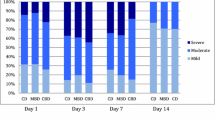Summary
Background and objectives
Tonsillectomy is a very painful procedure. Pain may be severe, and patients are often unable to perform in school or eat regular food for a number of days after the surgery. The aim of this study was to compare the quality of life after undergoing two different surgical techniques of tonsillectomy, harmonic scalpel and classic tonsillectomy with bipolar cauterization.
Design and setting
Prospective randomized double-blind, clinical trial study conducted in the ENT Department, Dr. Josip Benčević General Hospital, Slavonski Brod, Croatia.
Patients and methods
Data were collected, according to the type of operation, on pain persistence and intensity and returning to normal eating with tonsillectomy patients during the first seven postoperative days. Group A consisted of 50 children submitted to classic tonsillectomy with bipolar cauterization, while group B included 50 children operated on using the harmonic scalpel. Data on pain intensity were obtained using pain measuring scales adjusted to children’s age (Faces scales, visual analog scale). The first day of normal oral food intake was recorded.
Results
The analysis of variance revealed that the grade of pain significantly differs by a surgical technique employed, and that it significantly varied over the first seven postoperative days. The pain was more severe after undergoing the harmonic scalpel technique and children started to eat later compared with the classic tonsillectomy.
Conclusion
The classic tonsillectomy method with bipolar cauterization is the method of choice due to lower postoperative pain levels and sooner normal eating. The quality of life is better after undergoing the classic tonsillectomy method.
Zusammenfassung
Hintergrund und Ziele
Eine Tonsillektomie ist eine sehr schmerzhafte Prozedur. Der Schmerz kann sehr ausgeprägt sein. Die Kinder müssen oft mehrere Tage der Schule fern bleiben. Sie sind oft mehrere Tage nicht in der Lage, ein normales Essen zu sich nehmen. Ziel dieser Studie war es, die Lebensqualität nach einer mit zwei verschiedenen chirurgischen Methoden (harmonisches Skalpell versus klassische Methode einer bipolaren Kauterisierung) durchgeführten Tonsillektomie zu vergleichen.
Studiendesign
Prospektiv randomisierte Doppelblindstudie. Die klinische Studie wurde an der HNO Abteilung des Dr. Josip Benčević Allgemeinen Krankenhauses, Slavonski Brod, Kroatien durchgeführt.
Patienten und Methoden
Die Daten wurden entsprechend dem Operationstyp gesammelt. Erhoben wurde die Schmerzpersistenz und Intensität während der ersten sieben postoperativen Tage sowie die Zeit bis zur Wiederkehr zu normaler Nahrungsaufnahme. Die Gruppe A bestand aus 50 Kindern, die einer klassischen Tonsillektomie unterworfen wurden, die Gruppe B aus 50 Kindern, die eine Tonsillektomie mittels des klassischen Skalpells hinter sich hatten. Die Schmerzintensität wurde mittels einer für Kinder adaptierten Schmerzskala (Gesichts-Skala, visuelle Analog-Skala). Der erste Tag einer normalen Nahrungsaufnahme wurde festgehalten.
Ergebnisse
Die Varianzanalyse zeigte, dass der Grad des Schmerzes signifikant mit der chirurgischen Technik variierte und dass diese auch die ersten sieben postoperativen signifikant unterschiedlich war. Der Schmerz war nach den Tonsillektomien, die mittels der harmonischen Skalpell-Technik durchgeführt worden waren, ausgeprägter als nach Einsatz der klassischen Tonsillektomie-Technik Auch die normale Nahrungsaufnahme setzte bei der Gruppe, bei der das harmonische Skalpell angewandt wurde, später ein. Die Lebensqualität ist nach der klassischen Tonsillektomie besser als nach Einsatz der Technik des harmonischen Skalpells.
Schlussfolgerung
Die klassische Tonsillektomie mit bipolarer Kauterisation ist die Methode der Wahl, da die postoperativen Schmerzen geringer sind und die Kinder früher wieder normal Nahrung zu sich nehmen können.

Similar content being viewed by others
References
Kaiser AD Children’s tonsils in or out? A critical study of the end results of tonsillectomy. Vol. 2–3. Philadelphia: Lippincott; 1932. pp. 8–10.
Willging JP, Wiatrak BJ. Harmonic scalpel tonsillectomy in children: a randomized prospective study. Otolaryngol Head Neck Surg. 2003;128:318–25.
Husband AD, Davis A. Pain after tonsillectomy. Clin Otolaryngol Allied Sci. 1996;21:99–101.
Gallagher TQ, Wilcox L, Mc Guire E, Derkay C. Analyzing factors associated with major complications after adenotonsillectomy in 4,776 patients: comparing three tonsillectomy techniques. Otolaryng Head Neck Surg. 2010;142:886–92.
Kamal SA, Basu S, Kapoor L, Kulandaivelu G, Talpalikar S, Papasthatis D. Harmonic scalpel tonsillectomy: a prospective study. Eur Arch Otorhinolaryngol. 2006;263:449–54.
Prgomet D, Bura M, Bilić M, Janjanin S, Katić V. Ultrazvučni nož u kirurgiji glave i vrata, naše iskustvo s 159 bolesnika. Acta Med Sal. 2007;36(1):9–12 (in Croatian).
Tambić Andrašević A, Baudoin T, et al. ISKRA guidelines on sore throat: diagnostic and therapeutic approach- Croatian national guidelines. Liječ Vjesnik. 2009;131:181–91.
Friedman M, Ibrahim H, Bass L. Clinical staging for sleep-disordered breathing. Otolaryngol Head Neck Surg. 2002;127:13–21.
Krajina Z. Otorinolaringologija i cervikofacijalna kirurgija, II. Knjiga. Zagreb: Školska knjiga. 1986;457–80. (in Croatian)
Stelter K, Hempel JM, Berghaus A, Andratschke M, Luebbers CW, Hagedorn H. Application methods of local anaesthetic infiltrations for postoperative pain relief in tonsillectomy: a prospective, randomised, double-blind, clinical trial. Eur Arch Otorhinolaryngol. 2009;266:1615–20.
Timms MS, Temple RH. Coblation tonsillectomy: a double blind randomized controlled study. J Laryngol Otol. 2002;116(6):450–2.
Tan AKL, Hsu PP, Eng SP, Ng YH, Lu PKS, Tan SM, Say JH, Chan YH. Coblation versus electrocautery tonsillectomy: postoperative recovery in adults. Otolaryngol Head Neck Surg. 2006;135(5):699–703.
Wiatrak BJ, Willging JP. Harmonic scalpel for tonsillectomy. Laryngoscope. 2002;112:14–6.
Walker RA, Syed ZA. Harmonic scalpel tonsillectomy versus electrocautery tonsillectomy: a comparative pilot study. Otolaryngol Head Neck Surg. 2001;125:449–55.
Akural EI, Koivunen PT, Teppo H, Alahuhta SM, Lopponen HJ. Post-tonsillectomy pain: a prospective, randomised and double-blinded study to compare an ultrasonically activated scalpel technique with blunt dissection technique. Anaesthesia. 2001;56:1045–50.
Leaper M, Mahadevan M, Vokes D, Sandow D, Anderson BJ, West T. A prospective randomised single blinded study comparing harmonic scalpel tonsillectomy with bipolar tonsillectomy. Int J Pediatr Otorhinolaryngol. 2006;70:1389–96.
Samudrala J. A prospective trial with the Harmonic scalpel for tonsillectomy pain. Poster presented at the Annual Meeting of the American Academy of Otolaryngology-Head Neck Surgery, Washington DC; September, 2000.
Conflict of interest
The authors declare that there is no actual or potential conflict of interest in relation to this article.
Author information
Authors and Affiliations
Corresponding author
Rights and permissions
About this article
Cite this article
Pajić-Penavić, I., Đanić, D., Mrzljak-Vučinić, N. et al. Postoperative quality of life after two different methods of tonsillectomy. Wien Klin Wochenschr 125, 524–528 (2013). https://doi.org/10.1007/s00508-013-0411-6
Received:
Accepted:
Published:
Issue Date:
DOI: https://doi.org/10.1007/s00508-013-0411-6




